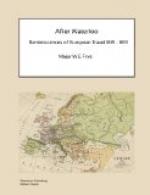I have put up in Turin in the Pension Suisse, where for seven franks per diem I have breakfast, dinner, supper and a princely bed room. The houses are in general lofty, spacious and on a grand scale.
[67] Francois Lamarque, born 1756, a member of the
Convention, ambassador
in Sweden, prefect of the
Tarn and member of the Cour de Cassation
(1804). He was exiled
in 1816.—ED.
[68] Major Frye (who wrote the name Despinassy) certainly
means
Antoine-Joseph Marie Espinassy
de Fontanelle’s (1787-1829), who was a
member of the Convention,
voted the King’s death and served in the
Republican army of the Alps.
In 1816, he was banished and went to
Lausanne, where he died 1829.—ED.
[69] Pardoux Bordas (1748-1842) was a member of the
Convention. Though he
had not voted the death of
Louis XVI, he was banished from France in
1816 and did not return there
before 1828.—ED.
[70] Antoine Francis Gauthier des Orcieres (1752-1838)
was elected to the
Etats Generaux in 1789, and,
in 1792, to the Convention, where he
voted the death of Louis XVI.
Later on, he was member of the Conseil
des Anoiena, juge au tribunal
de la Seine and conseiller a la cour
imperiale de Paris (1815).
Banished in 1816, he returned to France in
1828.
[71] Jean Baptists Michaud, a member of the Directoire
du departement du
Doubs, and a member of the
National Convention, voted the death of
Louis XVI and against the
proposed appeal to the people.—ED.
[72] Jean Daniel Paul Etienne Levade (1750-1834),
Protestant minister first
in England, then in Amsterdam,
finally minister at Lausanne and
professor of theology at the
Academie of the same town.—ED.
[73] Countess de Boigne, in her interesting Memoirs
(of which there is an
English translation) abstained
from describing her husband’s career in
India; this lends additional
interest to the information collected by
Major Frye,—ED.
[74] The manuscript has Sennar, a name quite unknown at Suza.—ED.
[75] Ariosto, Orlando Furioso, iv, 13, 5.—ED.
[76] This shield, now at the Armoria Reale,
is not antique, but is
ascribed to Benvenuto Cellini.—ED.
[77] This statue of Cupid is not antique, and has
been recently ascribed to
Michelangelo (Knapp, Michelangelo,
p. 155.)—ED.
CHAPTER VIII
Journey from Turin to Bologna—Asti—Schiller and Alfieri—Italian cuisine—The vetturini—Marengo—Piacenza—The Trebbia—Parma—The Empress Maria Louisa—Modena—Bologna—The University—The Marescalchi Gallery—Character of the Bolognese.




